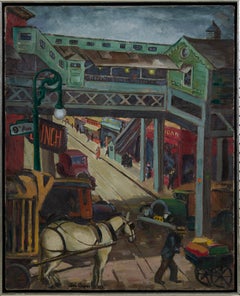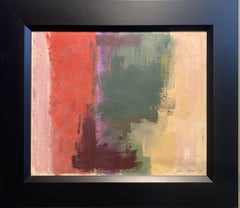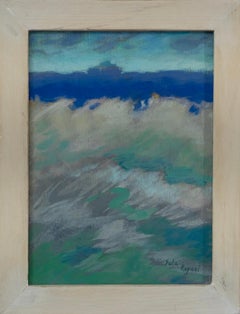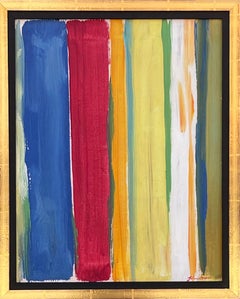John Opper Art
American, 1908-1994
John Opper described the 1930s as a "great gestation period" for his art. "I thought the Thirties was a very vital time for American art. . . . With the WPA, you got together whether it was the [Artists'] Union or the [American Artists'] Congress or whether it was a bar. . . and you talked about art, and you heard about important artists, and you began to live art." But Opper also remembered the thirties as a period of breakdown in the vitality of American art; "we became aware that a great deal was missing."
Academically trained like many of his contemporaries, Opper came to New York in 1934, two years after his graduation from Case Western Reserve University in Cleveland, Ohio. As a youth, he had taken Saturday art classes at the Cleveland Museum of Art and later studied at the Cleveland School of Art and the School of the Art Institute of Chicago. When he arrived in New York he was a well-trained painter, adept at rendering still lifes and particularly landscapes depicting the American scene. A reviewer of his 1937 exhibition at the Artists' Gallery in New York, for example, wrote about Opper's "colloquial flavor … spontaneity and an imaginative use of color which conveys just the feeling" that the subjects—East River tugboats, old garages, and scenes around Manhattan— suggested.
By 1937 Opper had become familiar with modernism, though he was not yet converted to the cause. Indeed, his 1937 show was made up of the still popular regionalist paintings. Earlier, in 1935 and 1936, he studied with Hans Hofmann and began to think in terms of forces and tensions within the picture plane. He met Wilfrid Zogbaum, Giorgio Cavallon, Byron Browne, Rosalind Bengelsdorf, and George McNeil, with whom he shared a studio. He paid frequent visits to Gallatin's Gallery of Living Art. He joined the WPA easel project in 1936 and began to paint in "a kind of transformed cubist style."
When war came, Opper worked for three years with a marine architectural firm making drawings for the pipe systems of PT boats. After the war, he taught at the University of Wyoming and the University of Alabama, and between 1952 and 1957, he was on the faculty at the University of North Carolina. In 1957, he began teaching at New York University, where he remained until his retirement in 1974.to
1
1
1
Overall Width
to
Overall Height
to
3
1
2
2
1
2
1
1
1
1
1
3
3
1
1
3
10,138
2,778
1,377
1,375
3
3
Artist: John Opper
Ninth Avenue El (New York City), Mid 20th Century Cityscape Oil painting
By John Opper
Located in Beachwood, OH
John Opper (American, 1908-1994)
Ninth Avenue El (New York City), c. 1935
Oil on canvas
Signed lower left and verso
30.125 x 24 inches
The Ninth Avenue El was the first elevated rai...
Category
1930s American Modern John Opper Art
Materials
Oil
Untitled Mid Century Abstract Oil Painting New York Artist
By John Opper
Located in Beachwood, OH
John Opper (American, 1908 - 1994)
Untitled, 1959
Oil on board
Signed and dated lower right
14.75 in. h x 18 in. w.
20 in. h. x 24.5 in. w., as framed
John Opper described the 1930s...
Category
1950s Abstract John Opper Art
Materials
Oil
Untitled
By John Opper
Located in Austin, TX
Waterline Fine Art, Austin, TX is pleased to present the following work:
Oil on canvas. Signed lower right, signed and dated verso.
62.25 x 56.25 in.
64 x 58 in. (framed)
Custom framed in a natural cherry wood floater.
Provenance
Washburn Gallery, New York
Behnke Doherty Gallery, Washington Depot, CT
Born in 1908 in Chicago, John Opper moved with his family to Cleveland, Ohio, in 1916. In high school, he began studying art and attending classes at the Cleveland Museum of Art.
After graduation, he enrolled in the Cleveland School of Art (now Cleveland Institute of Art), only to withdraw after a year and move to Chicago, where he took classes at the Art Institute of Chicago. He eventually returned to Cleveland, enrolling at Western Reserve University (now Case Western Reserve), receiving his bachelor’s degree in 1931. The Depression has taken hold during this period, so Opper found work by teaching metalworking and sketching classes at the Karamu Settlement House, the oldest African American theater in the United States.
In 1933, Opper traveled to Gloucester, Massachusetts, eventually connecting with the artist Hans Hofmann, who was teaching at the school run by Ernest Thurn. Hofmann encouraged Opper to work “in a more modern vein and start finding what it’s all about.” Heeding this advice, Opper relocated to New York, co-founding a mail-order club of American and British prints for dissemination to schools and museums.
By the mid-1930s, he joined the Works Progress Administration (WPA) Easel Division, and also began attending the 57th Street school that Hans Hofmann had established after leaving the Art Students League. Looking back at his time at the school, Opper felt that beyond Hofmann’s teaching, most advantageous was his contact with fellow artists, including Byron Browne, Rosalind Bengelsdorf, and George McNeil. At the time, he also met Giorgio Cavallon and the sculptor Wilfrid Zogbaum.
In 1936, Opper became a founding member of the American Abstract Artists, along with Balcomb and Gertrude Greene. The organization was formed to provide an opportunity for artists to show abstract works at a time when such opportunities were scarce. This led to his first solo show in 1937 at the Artists’ Gallery in New York.
During his summer in Gloucester in 1933, Opper came to know Milton Avery. Painting in Avery’s informal studio in New York City the following winter, he became acquainted with Adolph Gottlieb and Mark Rothko. Opper participated in a couple of shows during the 1930s of the American Artists Congress Against War and Fascism, whose president was Stuart Davis. About the same period, Opper joined the Artists’ Union and served as the business manager of its publication, Art Front.
During World War II, Opper worked for a ship design company creating drawings for piping systems used in PT boats...
Category
1950s Abstract Expressionist John Opper Art
Materials
Canvas, Oil
$25,000
Related Items
Original-Roses, Gladiolus, Hydrangeas-Summer Bloom Series-British Awarded Artist
Located in London, GB
This painting marks Shizico Yi’s joyful return to en plein air painting in her garden after a season of unpredictable weather—storms and heatwaves arriving in sudden turns.
By late J...
Category
2010s Abstract Impressionist John Opper Art
Materials
Gesso, Canvas, Oil, Acrylic
$1,221
H 23.63 in W 19.69 in D 0.6 in
Abstract Coastal Seascape Oil Painting on Wood Panel Blue Green Contemporary
By Sula Repani
Located in FISTERRA, ES
Abstract seascape oil painting on wood panel with blue, green and grey tones evoking the calm motion of the sea and a shifting coastal h...
Category
2010s Abstract John Opper Art
Materials
Oil, Board
$536
H 12.41 in W 9.65 in D 1.97 in
Till the Clouds Roll By 1945 Frank Sinatra Mid Century Modern Hollywood Film WPA
By Richard Whorf
Located in New York, NY
Till the Clouds Roll By 1945 Frank Sinatra Mid Century Modern Hollywood Film WPA
TILL THE COULDS ROLL BY (Film Set), oil on canvas, 20 x 24 inches signed “Richard Whorf” lower right and signed and dated on the verso “R. Whorf/ Dec. 21, 1945. Frame by Hendenryk.
ABOUT THE PAINTING
This painting is from the collection of Barbara and Frank Sinatra, dated December 21, 1945 (just nine days after Frank Sinatra’s 30th birthday), and depicts the Metro-Goldwyn-Mayer Culver City backlot during the filming of Till the Clouds Roll By, the direction of the film having been taking over by Richard Whorf in December 1945. It is not presently clear if Whorf gave the Sinatras this painting as a gift, as the presence of the Dalzell Hatfield Galleries label on the verso indicates the painting may have been sourced there. Frank and Nancy Sinatra acquired a number of works from Dalzell Hatfield Galleries during the 1940’s, or perhaps they framed it for the couple.
Sinatra performed “Old Man River’ in the film. Sinatra and June Allyson are depicted in the center of the painting.
PROVENANCE From the Estate of Mrs. Nancy Sinatra; Dalzell Hatfield Galleries, Ambassador Hotel, Los Angeles.
An image of the Dalzell Hatfield label and the back of the original frame (which we replaced with a stunning Heydenrk frame) are attached.
Nancy Sinatra was Fran's first wife. Nancy Rose Barbato was 17 years old when she met Frank Sinatra, an 18-year-old singer from Hoboken, on the Jersey Shore in the summer of 1934. They married in 1939 at Our Lady of Sorrows Church in Jersey City where Frank gave Nancy a recording of a song dedicated to her titled "Our Love" as a wedding present. The young newlyweds lived and worked in New Jersey, where Frank worked as an unknown singing waiter and master of ceremonies at the Rustic Cabin while Nancy worked as a secretary at the American Type Founders.
His musical career took off after singing with big band leaders Harry James and Tommy Dorsey...
Category
1940s American Modern John Opper Art
Materials
Canvas, Oil
$75,000
H 31 in W 27 in D 2 in
Midnight Jasmine-Original Oil with Gold Leaf-British Awarded Artist-Expression
Located in London, GB
This painting is a part of the Summer Bloom Series. Night Bloom Jasmine, commonly known as Lady of the Night, has the sweetest scent and attracts moths and bats in the wild,
though i...
Category
2010s Abstract Expressionist John Opper Art
Materials
Gold Leaf
$1,221
H 19.49 in W 15.36 in D 0.52 in
Original-La Vie en Rose-Awarded Artist-British School-Expression-Summer Bloom
Located in London, GB
Summer Bloom series began in 2022, where Shizico Yi celebrating the season by painting en plein air in her garden. In 2024, she embarks on a fresh chapter with her new rose garden. T...
Category
2010s Abstract Expressionist John Opper Art
Materials
Gesso, Cotton Canvas, Oil, Acrylic
$1,180
H 15.75 in W 11.82 in D 0.6 in
Coney Island, Fourth of July
Located in Los Angeles, CA
Coney Island, Fourth of July, c. 1940s, oil on canvas applied to Masonite, signed upper right, 26 x 21 1/2 inches, presented in its original frame
During the 1930s and 40s, Coney I...
Category
1940s American Modern John Opper Art
Materials
Canvas, Oil, Board
Original-Dahlias in Dusk-Gold Leaf and oil-British Awarded Artist-abstract
Located in London, GB
With strokes of Gold, Oil, Gesso and Acrylic, Shizico painted a visual symphony of abstract expression in this on-going series [Landscape Memories]; it's a part of her [Sunlit Series...
Category
2010s Abstract Impressionist John Opper Art
Materials
Gold Leaf
$532 Sale Price
20% Off
H 19.61 in W 15.67 in D 0.56 in
Original-Sunset Song II-British Awarded Artist-Impressionism-Plein Air evening
Located in London, GB
Sunset Song Series was created entirely en plein air, painted directly under the dimming light of late-summer and autumn sunsets and moonlight, with no artificial light to guide her...
Category
2010s Abstract Impressionist John Opper Art
Materials
Gesso, Canvas, Oil, Acrylic, Wood Panel
$1,084
H 15.75 in W 11.82 in D 0.2 in
Original-Sunset Song-en plein air Oil-British Awarded Artist-Lime Tree vs sunset
Located in London, GB
Sunset Song Series was created entirely en plein air, painted directly under the dimming light of late-summer and autumn sunsets. This work is a meditation on seeing without looking ...
Category
2010s Abstract Impressionist John Opper Art
Materials
Gesso, Canvas, Oil, Acrylic
$1,221
H 23.63 in W 19.69 in D 0.71 in
Original-Magic Bell in the Night-UK Awarded Artist-Botanical Abstract Expression
Located in London, GB
In her latest series, "The Weaver," Shizico explores forms, layers, and time onto canvases. Applying the format of diptychs and triptychs, she creates lyrical narratives, capturing t...
Category
2010s Abstract Expressionist John Opper Art
Materials
Gesso, Canvas, Oil, Acrylic, Wood Panel
$672
H 15.75 in W 11.82 in D 0.12 in
Original-Dahlias with Cat -British Awarded Artist-gold leaf and oil on canvas
Located in London, GB
In her 'Prayers,' series, Shizico incorporates Dahlias, which bloom in the late summer, bringing vibrancy to the garden into the winter's chilly months. The innocence of a cat serves...
Category
2010s Abstract Impressionist John Opper Art
Materials
Copper, Gold Leaf
$988
H 19.49 in W 15.56 in D 0.56 in
Colorado Hill Town with Storm Clouds, 1940s Modernist Landscape, Lush Green
By Paul Kauver Smith
Located in Denver, CO
This WPA-era signed oil painting by Paul K. Smith captures a stormy summer landscape in Colorado, featuring houses and lush trees under dramatic storm clouds. Painted in rich shades ...
Category
1940s American Modern John Opper Art
Materials
Oil
$1,950 Sale Price
35% Off
H 29 in W 33 in D 1.25 in
Previously Available Items
Untitled abstract blue, red & yellow oil painting, New York artist
By John Opper
Located in Beachwood, OH
John Opper (American, 1908-1994)
Untitled
Oil on canvas
Signed lower right
20 x 16 inches
22.25 x 18.25 inches, framed
John Opper described the 1930s as a "great gestation period" for his art. "I thought the Thirties was a very vital time for American art. . . . With the WPA, you got together whether it was the [Artists'] Union or the [American Artists'] Congress or whether it was a bar. . . and you talked about art, and you heard about important artists, and you began to live art." But Opper also remembered the thirties as a period of breakdown in the vitality of American art; "we became aware that a great deal was missing."
Academically trained like many of his contemporaries, Opper came to New York in 1934, two years after his graduation from Case Western Reserve University in Cleveland, Ohio. As a youth, he had taken Saturday art classes at the Cleveland Museum of Art and later studied at the Cleveland School of Art and the School of the Art Institute of Chicago. When he arrived in New York he was a well-trained painter, adept at rendering still lifes and particularly landscapes depicting the American scene. A reviewer of his 1937 exhibition at the Artists' Gallery in New York, for example, wrote about Opper's "colloquial flavor … spontaneity and an imaginative use of color which conveys just the feeling" that the subjects—East River tugboats, old garages, and scenes around Manhattan— suggested.
By 1937 Opper had become familiar with modernism, though he was not yet converted to the cause. Indeed, his 1937 show was made up of the still popular regionalist paintings. Earlier, in 1935 and 1936, he studied with Hans Hofmann and began to think in terms of forces and tensions within the picture plane. He met Wilfrid Zogbaum, Giorgio Cavallon, Byron Browne, Rosalind Bengelsdorf, and George McNeil, with whom he shared a studio. He paid frequent visits to Gallatin's Gallery of Living Art. He joined the WPA easel project in 1936 and began to paint in "a kind of transformed cubist style."
When war came, Opper worked for three years with a marine architectural firm making drawings for the pipe systems of PT boats...
Category
Mid-20th Century Color-Field John Opper Art
Materials
Oil
John Opper art for sale on 1stDibs.
Find a wide variety of authentic John Opper art available for sale on 1stDibs. You can also browse by medium to find art by John Opper in paint, canvas, fabric and more. Much of the original work by this artist or collective was created during the 20th century and is mostly associated with the abstract style. Not every interior allows for large John Opper art, so small editions measuring 46 inches across are available. Customers who are interested in this artist might also find the work of Michael Goldberg, Syd Solomon, and Agnes Hart. John Opper art prices can differ depending upon medium, time period and other attributes. On 1stDibs, the price for these items starts at $25,000 and tops out at $55,000, while the average work can sell for $40,000.




